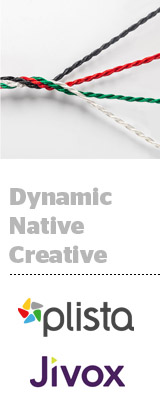
Brands want to spend more on native, and plista, the native arm of WPP’s Xaxis, is hoping to oblige through a partnership with dynamic creative optimization platform Jivox.
After several months of testing, the duo rolled out a solution on Tuesday to help plista and GroupM clients create and buy native ads programmatically and personalize them in real time.
As consumers browse sites across devices, plista taps into marketer data from [m]insights (formerly Turbine), a proprietary data management platform used by Xaxis and housed within GroupM.
Jivox then uses the DMP and other data sources, including demographics and product preferences, to identify different targeted ad versions that fit into the surrounding content. The solution also layers in contextual data triggers, such as weather, time of day and day of the week, in order to customize the ads.
An increasing number of the advertisers that plista works with are turning to native as a way to drum up engagement, said Elizabeth Harrington, head of plista North America. The company’s client base is roughly 15% direct, with the rest rounded out by programmatically minded GroupM clients.
“They see native as a more positive experience, something that’s more welcome within the content, as opposed to being disruptive,” Harrington said.
But the main reason native spend is rising – eMarketer predicts that native digital display will grow more than 36% in the US this year – is because the format is inherently mobile, said Jivox CEO Diaz Nesamoney.
“On mobile, there’s no right rail, there’s no top rail, so blending with the content makes a lot of sense,” he said.
Native, whether it’s outstream, in-feed or in the form of a content recommendation, can also help advertisers get away from “the incredibly annoying ads that led to ad blocking in the first place,” Nesamoney said. The #1 reason why people block ads: Ads foul up the user experience.
The number of dynamic native ad versions plista can create for clients through the Jivox collaboration depends only on the number of elements the advertiser wants to toss in the mix.
For a large ecommerce retailer with a catalog of thousands of products, for example, the combinations of items with various special offers and different images and ad copy can run into the millions. For a small brand, it might just be 20 or 30 different creative and messaging combinations.
The solution scales by assembling the creative in the moment, Nesamoney said.
“It’s specific creative for the user and the context that user is in,” he said. “Scale here comes by a component approach, taking various creative assets and lines of copy and putting it together in a way that’s relevant to the user on the fly, based on what we know about them, including what they recently browsed, looked at and are interested in.”
A native ad seems simple enough when stripped down to its basic elements, but serving one in real time is complicated by creative that must be assembled and rendered on the publisher side, as opposed to standard static programmatic display.
Before launching the solution, Jivox and plista had to ensure that publishers could handle all that and send back the appropriate reporting and analytics to do real-time optimization.
It’s a tricky process.
That’s why Jivox used the Interactive Advertising Bureau’s dynamic content ad standard, which defines the various components and asset variations in an ad unit, so that they can be reassembled across platforms and look different depending on the recipient. Nesamoney serves as co-chair of the IAB Tech Lab Dynamic Ad Standard Working Group and was involved with creating the standard, which was released last year.
The ultimate goal is to offer customization, regardless of the platform.
“We see this solution as an omnichannel opportunity, a multiformat opportunity across all different devices,” plista’s Harrington said. “Dynamic creative is a key aspect of innovating native advertising.”
This post was syndicated from Ad Exchanger.

More Stories
Streaming Platforms Must Become Performance Channels To Stay On Wall Street’s Good Side
New board member for Blutui
BTS With Studs: The Gen Z-Friendly Challenger Taking on Claire’s